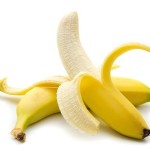 The A-Peel of a Banana
The A-Peel of a Banana
I could swear my son is half monkey—judging by all the bananas he eats! He is a finicky banana-consumer, although, in that he only likes to eat these fruits before they fully ripen (bearing a tinge of green around the edges). When I explained to him that bananas are better eaten when their skins are fully yellow, showing a few “age spots”, he simply shrugged off my advice and said, “This is the way I like them.”
Truth be told, there isn’t a “right time” to eat a banana. Our alternative views on their “edible readiness” each have unique merit, all the while maintaining their common, a-peeling character traits. These pre-packaged, yellow smiles contain three grams of fiber and only about 100 calories for a fruit of medium-size. A true complex carbohydrate food without an ounce of fat! Whether they are eaten under-ripe, “just-ripe”, or over ripened, they carry an impressive amount of manganese, potassium, and vitamins C and B6.
Now, if a banana is consumed in its starchy, yellow-to-slightly green state (the way my son finds them a-peeling), its fiber content is more insoluble and therefore better in assisting with regularity of bowel movements. Consumed when showing a bit of age (spots), bananas contain a higher concentration of antioxidants (anti-aging molecules) and soluble fiber, which has been shown to reduce cholesterol levels…but they also contain a bit more sugar. So, if you are diabetic (or trying to protect yourself from such metabolic issues), chose to eat your bananas in a somewhat pre-ripened state or eat half a ripened banana with some nut butter smeared across it; the fat content of which will prevent a spike in your blood sugar.
One final thing to note about bananas is that you do not have to spend the extra money to buy organic. These fruits are so thick skinned, very little contamination can make it through such a venerable force-field! And speaking of peels—please discard wisely, or you will be setting the stage for a comedic slip and fall routine.